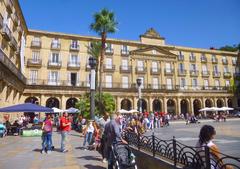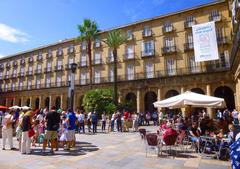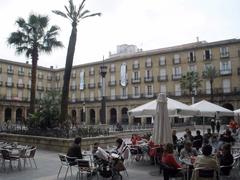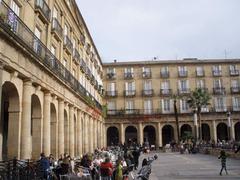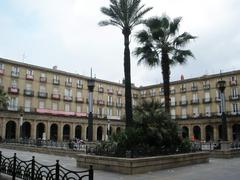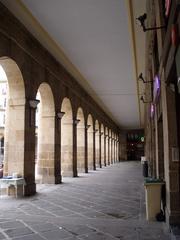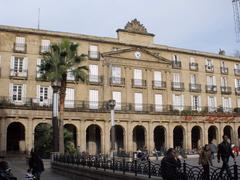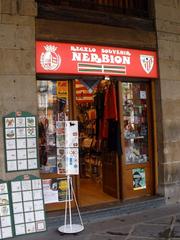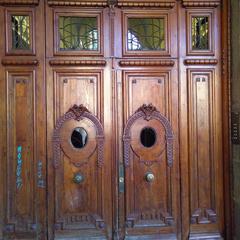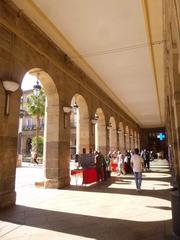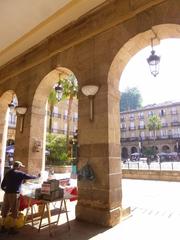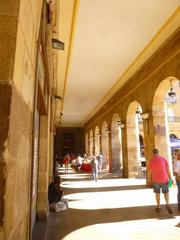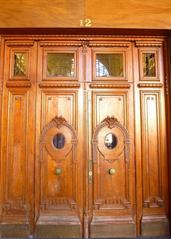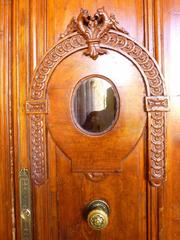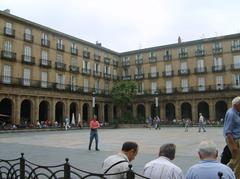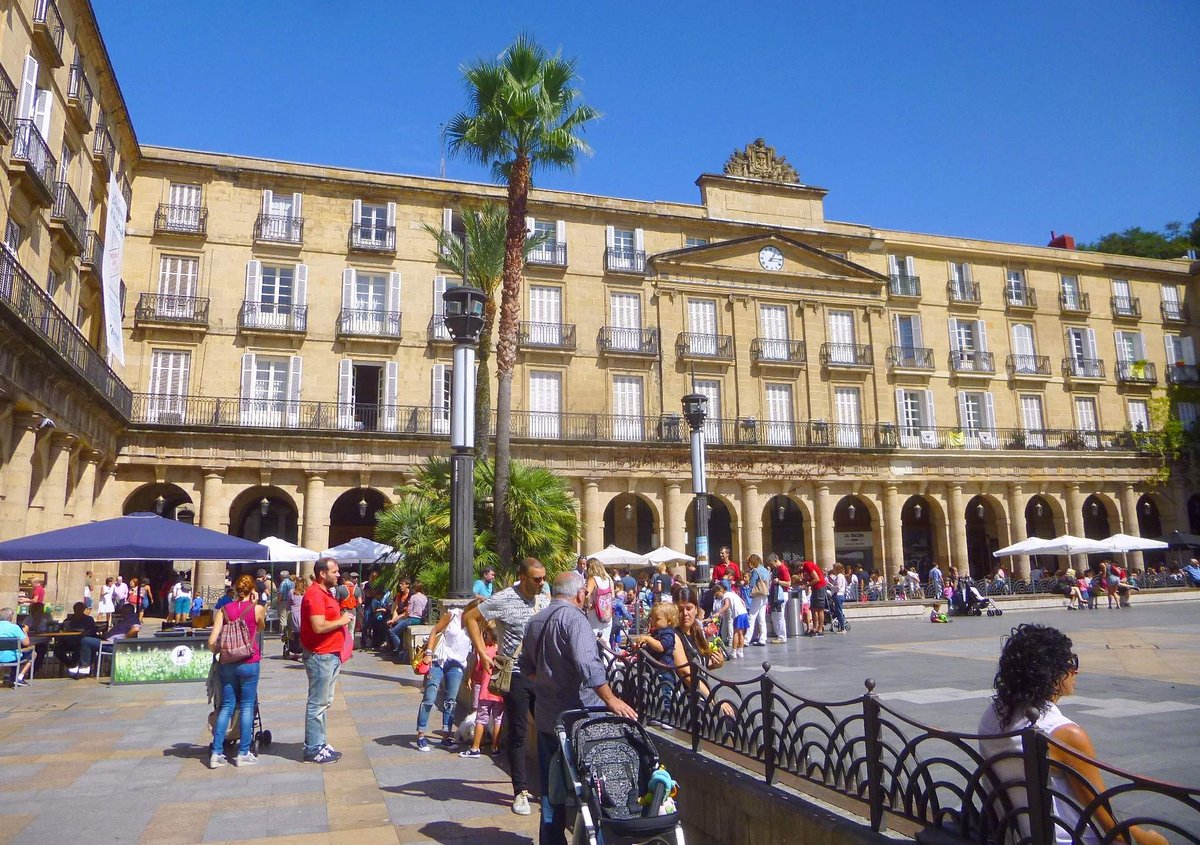
Plaza Nueva Bilbao: Visiting Hours, Tickets, and Historical Sites Guide
Date: 14/06/2025
Introduction
Plaza Nueva, situated in the heart of Bilbao’s Casco Viejo (Old Town), stands as a testament to the city’s cultural richness and architectural grandeur. Completed in 1851, this neoclassical square is celebrated for its harmonious arcades, golden sandstone facades, and lively atmosphere where history, gastronomy, and Basque traditions converge. Today, Plaza Nueva is not only an architectural marvel but also a vibrant social hub, hosting iconic pintxos bars, bustling markets, and a year-round calendar of cultural events (Barceló Guide; Euskadi Tourism; Lonely Planet).
This comprehensive guide covers Plaza Nueva’s historical origins, architectural significance, cultural role, practical visitor information, and nearby attractions. Whether you are a history buff, food enthusiast, or simply eager to immerse yourself in Bilbao’s vibrant urban life, this article provides all you need to appreciate and enjoy Plaza Nueva.
Table of Contents
- Origins and Historical Evolution
- Architectural Features and Design
- Historical Functions and Social Role
- Visiting Plaza Nueva: Practical Information
- Gastronomy: Pintxos Culture & Top Bars
- Events and Festivals
- Visitor Tips and Practical Information
- Frequently Asked Questions (FAQ)
- Conclusion & Recommendations
- References
Origins and Historical Evolution
Plaza Nueva’s conception traces back to the Enlightenment ideals that inspired Bilbao’s urban transformation in the late 18th and early 19th centuries. The decision to build a new civic center was made in 1786, but actual construction began in 1828. Political, economic, and engineering challenges delayed completion until 1851 (Bilbao Turismo). The chosen site, previously marshland between Casco Viejo and the fishing district of San Nicolás, quickly became a focal point for social, political, and commercial life (Barceló Guide).
Notably, in 1872, the square was transformed into a Venetian-style lagoon to honor King Amadeo I, and during the Franco era, it was renamed Plaza de los Mártires before reverting to its original name with the return of democracy, reflecting Bilbao’s strong attachment to its heritage.
Architectural Features and Design
Layout and Structure
Plaza Nueva is a prime example of Spanish neoclassical architecture, measuring about 3,400 square meters and enclosed by uniform, four-story arcaded buildings. Designed by Silvestre Pérez, Antonio Echevarría, and Avelino Goikoetxea, the plaza is defined by its 64 arches, supported by square pillars and Doric columns, creating rhythmic symmetry and sheltering lively walkways (Euskadi Tourism; Spotting History).
Notable Architectural Elements
The facades are constructed from golden sandstone, with wrought-iron balconies above the arcades. Distinctive elements include a central clock and the emblem of the Lord of Biscay, referencing the square’s historic administrative role. The plaza features five entrances—four original and one added after Spanish Civil War damage (Barceló Guide). Though original gardens were removed in 1966 to make way for underground parking, clusters of trees now provide greenery at each corner.
Historical Functions and Social Role
Plaza Nueva was historically the seat of the Biscay government, later housing the Banco de Bilbao and now the headquarters of Euskaltzaindia, the Royal Academy of the Basque Language (Spotting History; The Crazy Tourist). The arcades are home to some of Bilbao’s oldest taverns and shops, integral to the city’s pintxos culture.
The square is a hub for public events: weekly Sunday flea markets, folk demonstrations, open-air concerts, and major festivals such as Aste Nagusia. Its role as a communal living room for locals and visitors is central to Bilbao’s social life (Barceló Guide).
Visiting Plaza Nueva: Practical Information
Visiting Hours & Tickets
- Square Access: Plaza Nueva is open 24/7 and free to access—no tickets required.
- Individual Establishments: Bars, restaurants, and shops generally open from mid-morning until midnight.
Accessibility
- The plaza is wheelchair and stroller accessible, with flat cobblestone paving and ramps at entrances.
- Vehicular traffic is prohibited, ensuring safety for all visitors.
Best Times to Visit
- Early mornings & weekdays: Quieter for photography or a relaxed stroll.
- Evenings & weekends: Lively atmosphere ideal for pintxos, socializing, and markets.
- Sundays: The flea market attracts locals and tourists seeking antiques, crafts, and rare finds.
Guided Tours & Special Events
- Plaza Nueva features prominently on guided walking tours of Casco Viejo, which provide historical and cultural context.
- During festivals like Aste Nagusia, the square hosts concerts, folk dances, and public celebrations.
Nearby Attractions
- Santiago Cathedral: A Gothic landmark just a few minutes’ walk away.
- Ribera Market: Europe’s largest covered food market, nearby along the river.
- Archaeological Museum: Offers insight into Basque history and culture.
- Teatro Arriaga & Paseo del Arenal: Iconic theatre and scenic riverfront promenade.
- Guggenheim Museum Bilbao & Fine Arts Museum: Both within walking distance or a short tram ride (The Crazy Tourist; PlanetWare).
Gastronomy: Pintxos Culture & Top Bars
Plaza Nueva is renowned for its pintxos bars, where Basque culinary tradition shines. Pintxos are small, creative snacks, often enjoyed with local txakoli wine or cider.
Recommended Bars:
- Gure Toki: Michelin-recommended for inventive pintxos.
- Victor Montes: A classic featuring traditional Basque flavors.
- Café Bar Bilbao: Beloved by locals for its wide selection and ambiance.
- Sorginzulo: Known for contemporary twists on classic bites.
Tips: Move from bar to bar (“poteo”), sample a variety, and pay by counting toothpicks or plates at the end (Everybody Hates a Tourist; PlanetWare).
Traditional taverns also serve Basque classics like bacalao al pil-pil, marmitako, and txipirones en su tinta. Don’t miss txakoli, the local sparkling white wine, poured theatrically from a height.
Events and Festivals
Regular Events
- Sunday Flea Market: Each Sunday morning, Plaza Nueva transforms into a bustling market with antiques, books, coins, and crafts (Spain.info; Wikipedia).
- Santo Tomás Farmers’ Market: December 21st, featuring seasonal produce, cheeses, and Basque specialties.
Annual Festivals
- Aste Nagusia (Great Week): Every August, the square becomes a stage for concerts, dance performances, and food stalls (Spain.info; Lonely Planet).
- Music Festivals: Plaza Nueva participates in festivities related to BBK Live, Blues Festival, and Music Legends, often hosting live performances and gatherings (La Troupe).
Special Events
- The square has hosted unique happenings, from chess tournaments to open-air art exhibitions.
- Free public Wi-Fi is provided by the city council (Wikipedia).
Visitor Tips and Practical Information
- Best Time to Visit: Late afternoons and evenings for a lively atmosphere; Sundays for the flea market.
- Reservations: Most pintxos bars are walk-in, while fine dining restaurants may require reservations.
- Payment: Cards accepted; small cash is useful for markets.
- Safety: Plaza Nueva is generally safe; as with any busy area, keep an eye on personal belongings.
- Facilities: Restrooms in most bars, benches and outdoor seating in the square, and Wi-Fi at many establishments.
Getting There: Easily reached by foot, metro (Casco Viejo station), tram, or bus. The square is pedestrianized and accessible.
Frequently Asked Questions (FAQ)
Q: What are Plaza Nueva’s visiting hours?
A: The square is open to the public 24/7 with no entry fee.
Q: Are tickets required?
A: No, Plaza Nueva does not require tickets for entry.
Q: Is Plaza Nueva wheelchair accessible?
A: Yes, it is fully accessible for wheelchairs and strollers.
Q: Are guided tours available?
A: Yes, many city walking tours include Plaza Nueva.
Q: When is the best time to visit?
A: For a lively atmosphere, visit in the evening or during the Sunday market; for a quieter experience, try weekday mornings.
Conclusion & Recommendations
Plaza Nueva is more than a neoclassical square—it is the beating heart of Bilbao’s old town, where history, architecture, gastronomy, and local culture come together. Whether enjoying pintxos in a centuries-old tavern, browsing the Sunday flea market, or taking in a festival performance, Plaza Nueva offers an authentic slice of Basque life. Its central location, accessibility, and vibrant calendar of events make it an essential stop for any visitor to Bilbao.
Plan your visit to coincide with special events or simply enjoy the daily rhythm of the square. For enhanced experiences, consider guided tours, and use resources like the Audiala app for interactive maps and insider tips.
Embrace Plaza Nueva as a place where Bilbao’s past and present intertwine, and let it be your gateway to exploring the city’s rich heritage.
References
- Barceló Guide: Plaza Nueva Bilbao
- Euskadi Tourism: Plaza Nueva Square
- Bilbao Turismo: Plaza Nueva
- Spotting History: Plaza Nueva
- The Crazy Tourist: 15 Best Things to Do in Bilbao
- Lonely Planet: Plaza Nueva
- Bilbonauta: Plaza Nueva
- Everybody Hates a Tourist: Pintxos Bars in Bilbao
- PlanetWare: Bilbao Attractions
- Spain.info: Plaza Nueva Bilbao
- La Troupe: Best Summer Festivals in Bilbao
- Wikipedia: Plaza Nueva, Bilbao
- Spainist: Best Restaurants in Bilbao
- The Travel Pages: Ten Best Restaurants in Bilbao
Image suggestions:
- Wide-angle photo of Plaza Nueva’s arcades bustling with people enjoying pintxos (alt text: “Plaza Nueva Bilbao arcaded buildings and lively atmosphere”)
- Close-up of the clock and emblem atop the colonnades (alt text: “Clock and emblem of the Lord of Biscay at Plaza Nueva”)
- Scene from the Sunday flea market (alt text: “Sunday flea market at Plaza Nueva Bilbao”)
- Map showing Plaza Nueva within Casco Viejo and proximity to landmarks
For more travel tips and interactive guides, download the Audiala app and follow us on social media for the latest updates and events.
